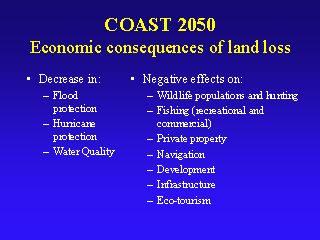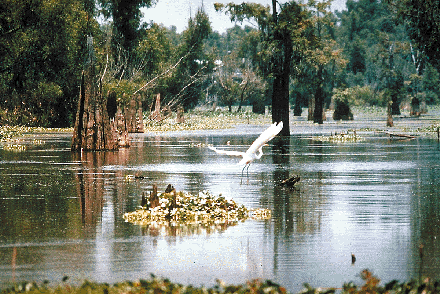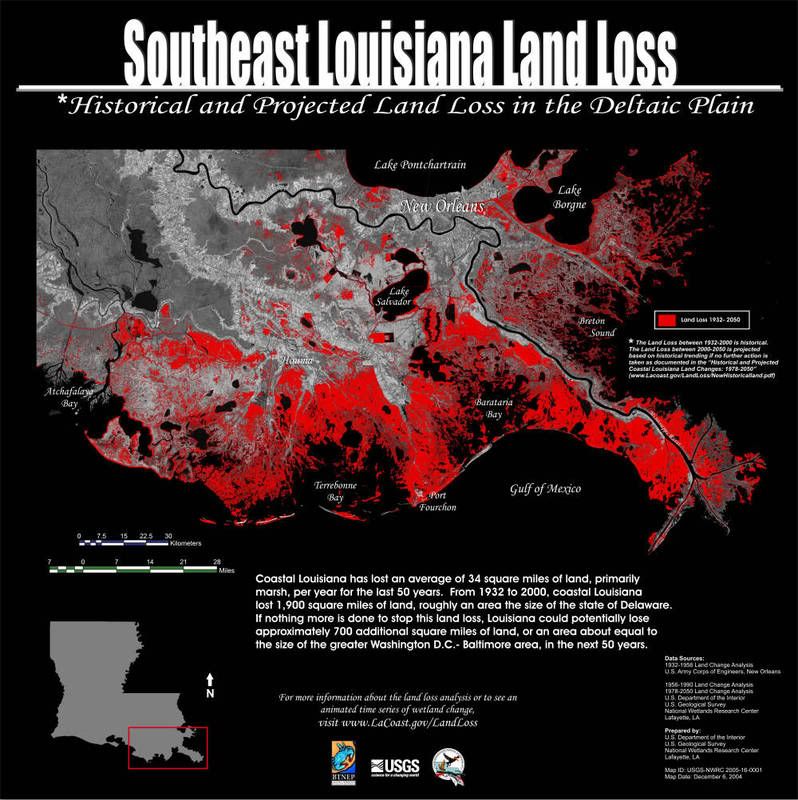 In Bridge at the Edge of the World: Capitalism, the Environment, and Crossing from Crisis to Sustainability, James Gustave Speth discusses how capitalism is inherently destructive to a sustainable environment, community and popular democracy. The drive for economic expansion and accumulation is based on cost-benefit analyses for projects that do not include the economic, environmental or social costs caused by the destruction of natural resources. This results in false price tags for projects because we either pay upfront or we pay much higher costs later. Speth warns that we are now at the bridge of an environmental calamity and must choose between two paths: one path is business as usual and leads to certain destruction; the other path is a bridge that will help us cross to safety. This bridge stretches across America, but today we look at the Gulf Coast region.
In Bridge at the Edge of the World: Capitalism, the Environment, and Crossing from Crisis to Sustainability, James Gustave Speth discusses how capitalism is inherently destructive to a sustainable environment, community and popular democracy. The drive for economic expansion and accumulation is based on cost-benefit analyses for projects that do not include the economic, environmental or social costs caused by the destruction of natural resources. This results in false price tags for projects because we either pay upfront or we pay much higher costs later. Speth warns that we are now at the bridge of an environmental calamity and must choose between two paths: one path is business as usual and leads to certain destruction; the other path is a bridge that will help us cross to safety. This bridge stretches across America, but today we look at the Gulf Coast region.
There are two issues that I have raised in my diaries that Speth brings together in a nice package. One, environmental issues today are intertwined with social inequality and the loss of popular democratic governance. In order to truly provide recovery from Katrina, and also prevent or reduce future impacts from “Katrina storms,” we need recovery plans that address the full spectrum of environmental issues, including social justice, human rights, civil rights, health care, poverty and economic well-being.
The second point is the need for transformation of ecological and economic values so that projects are based on environmental accounting. Presently, corporations and our government calculate economic growth by not including the costs to our environment and social system. When a project or action is authorized, our government does not calculate all the costs, which include environmental damages, clean-ups, subsidies for resource extractions, deregulation, immunity, costs of resource depletions and pollution, recovery and economic costs from the environmental disaster waiting in the wings and other forms of corporate welfare. The inclusion of these costs at the front end will save lives and be economically cheaper by incorporating sustainability into projects to avoid exponentially higher costs in the future.
Our government’s failure to use these two principles when approving projects for the Gulf Region resulted in Americans losing lives and increased the environmental, economic and social costs from Katrina.
 Our government has long known that the Gulf Region was not prepared for “Katrina storms.” Yet, instead of implementing measures to protect the Gulf Region, our government pursued a path of ostensibly cheap fixes. Thus, in the 1940s, our government constructed levees that were only intended to provide protection to cows. In reality, the fixes were not cheap because the costs of environmental disasters were not factored into the price.
Our government has long known that the Gulf Region was not prepared for “Katrina storms.” Yet, instead of implementing measures to protect the Gulf Region, our government pursued a path of ostensibly cheap fixes. Thus, in the 1940s, our government constructed levees that were only intended to provide protection to cows. In reality, the fixes were not cheap because the costs of environmental disasters were not factored into the price.
Our government authorized oil and gas extractions that caused land subsidence and land losses that protect the area from storm surges. Since the late 1920s, 10,000 miles of oil and natural gas pipelines, canals and navigation channels have caused saltwater intrusion and coastal erosion, which then caused sinkage.
Our government leveed the Mississippi River to prevent annual flooding to enable expansion of farms and industries on the banks. Corporate enhancement trumped eco costs, such as needing these floods to dump sediment across the Delta and barrier islands to rebuild each year what storms had eroded and to hold back saltwater intrusions that kill the marsh vegetation of wetlands which created a buffer against storm surges and weakened strong winds. Even Gov. Jindal knows that “every 2 miles of healthy wetlands reduce tidal surge by a foot.” Thus, the government left the “city naked against the sea.”
 One final example is our government allowing the quick fix of using newspaper instead of rubber joints (h/t TheBlaz) to fix floodwalls of NOLA levee because there was insufficient monies to do the work properly in a $2 million contract, earning the contractor a WORST by Keith.
One final example is our government allowing the quick fix of using newspaper instead of rubber joints (h/t TheBlaz) to fix floodwalls of NOLA levee because there was insufficient monies to do the work properly in a $2 million contract, earning the contractor a WORST by Keith.
The point is that Katrina recovery should be based on plans that focus on social, economic and environmental sustainability upfront in order to prevent, reduce, or at least not exacerbate a “Katrina storm,” rather than applying governmental band-aids after a disaster hits. We already have Katrina recovery plans which use environmentally friendly materials, energy smart operational features and engineering and architecture designed to work with the natural environment rather than trying to control our environment. The objectives are to reduce the project’s carbon footprints and adverse environmental impacts as well as to sustain and enhance our environment and our community for future generations. We just need to gather the political wisdom to implement.
Meteor Blades has offered a “new city paradigm” called “Eco New Orleans,” which is based on “sustainability” or “meeting the needs of the present without compromising the ability of future generations to meet their own needs.” Two examples from Eco New Orleans illustrate how an environmental accounting for projects that consider the spectrum of eco issues can in the end game be economically cheaper while saving lives and promoting social justice and community.
 One solution is the Coast 2050 or the Louisiana Coastal Area Ecosystem Restoration Project, which is a “large-scale engineering plan” that was “developed in 1998 by scientists, Army engineers, metropolitan planners and Louisiana officials” and “might have helped save the city.”
One solution is the Coast 2050 or the Louisiana Coastal Area Ecosystem Restoration Project, which is a “large-scale engineering plan” that was “developed in 1998 by scientists, Army engineers, metropolitan planners and Louisiana officials” and “might have helped save the city.”
The Coast 2050 plan includes the use of floodgates to allow sediment and freshwater to flow to the delta to reestablish the delta; the use of seagates across the straits that connect Lake Pontchartrain to the gulf to stop the wall of water from filling the lake, which then overflows into NOLA and also raising, extending and strengthening the levees, canal walls and pumping systems.
 The Coast 2050 plan costs $14 billion. Bushie ordered the plan downsized by 80% for a $1.2 billion project. However, in 2000, Congress authorized $7 billion to restore the Florida Everglades, which is half the size of the Coast 2050 restoration area and does not involve direct impacts of saving lives. The upshot is that $14 billion is only a fraction of the at least $133 billion in recovery funding for Katrina.
The Coast 2050 plan costs $14 billion. Bushie ordered the plan downsized by 80% for a $1.2 billion project. However, in 2000, Congress authorized $7 billion to restore the Florida Everglades, which is half the size of the Coast 2050 restoration area and does not involve direct impacts of saving lives. The upshot is that $14 billion is only a fraction of the at least $133 billion in recovery funding for Katrina.
 Another cost factor is the estimated $37 billion damage from not saving the loss of land, which may include the loss of NOLA as well as “fisheries, wildlife habitat, navigation, flood control, and hurricane protection.”
Another cost factor is the estimated $37 billion damage from not saving the loss of land, which may include the loss of NOLA as well as “fisheries, wildlife habitat, navigation, flood control, and hurricane protection.”
We either pay upfront or we pay a much higher price later. If Coast 2050 had been implemented in the 1990s, Katrina would not have been so devastating. “All it takes is a Category 5 direct hit, and we’ll all be thinking, ‘Why didn’t we invest in the coast when we had the chance?'” Jindal said. “It would have been cheaper to fix it in the first place.”
 Another component of the MB Eco Plan is affordable housing that is environmentally friendly, such as the Denny Park Apartments in Seattle. Denny Parks is one of a variety of affordable housing developments by Green Communities, which offers a wide range of architectural designs (please view at this link) based on using environmentally sustainable materials, reducing negative environmental impacts, increasing energy efficiency and providing easy access to community services and public transportation.
Another component of the MB Eco Plan is affordable housing that is environmentally friendly, such as the Denny Park Apartments in Seattle. Denny Parks is one of a variety of affordable housing developments by Green Communities, which offers a wide range of architectural designs (please view at this link) based on using environmentally sustainable materials, reducing negative environmental impacts, increasing energy efficiency and providing easy access to community services and public transportation.
 Some of the features in the housing developments include rainwater harvesting (pdf file) (or the collection and storage of rainwater from rooftops to be used for nonpotable purposes, such as watering lawns) which provides a new water source as well as reducing stormwater runoff pollution. Another feature in a farmworkers’ housing development is construction of sidewalks that “shed rainwater to landscaped areas for recharge.”
Some of the features in the housing developments include rainwater harvesting (pdf file) (or the collection and storage of rainwater from rooftops to be used for nonpotable purposes, such as watering lawns) which provides a new water source as well as reducing stormwater runoff pollution. Another feature in a farmworkers’ housing development is construction of sidewalks that “shed rainwater to landscaped areas for recharge.”
The Denny Park Apartments cost $11 million (pdf file) for 50 apartments over street-level commercial space. (The figure is 11 million but for some reason even dk system won’t hyperlink correctly.) FEMA has spent nearly $3 billion in emergency housing for the victims of Katrina and Rita, but has yet to provide permanent homes.
As Martin Luther King stated, tomorrow is today:
We are now faced with the fact, my friends, that tomorrow is today. We are confronted with the fierce urgency of now. In this unfolding conundrum of life and history, there is such a thing as being too late. Procrastination is still the thief of time. Life often leaves us standing bare, naked, and dejected with a lost opportunity. The tide in the affairs of men does not remain at flood – it ebbs. We may cry out desperately for time to pause in her passage, but time is adamant to every plea and rushes on. Over the bleached bones and jumbled residues of numerous civilizations are written the pathetic words, “Too late.” Martin Luther King, 4 April 1967, Riverside Church, New York City, “A Time to Break Silence.”

7 comments
Skip to comment form
Author
…maybe obama will like.
http://www.nytimes.com/2007/11…
and this seems like a great step in the right direction.
unlimited growth leads to environmental degradation and is unsustainable is very important. It’s so clear to me in fighting MTR coal mines and other projects needing water permits that the costs to the environment are not considered.
Thanks for this diary.